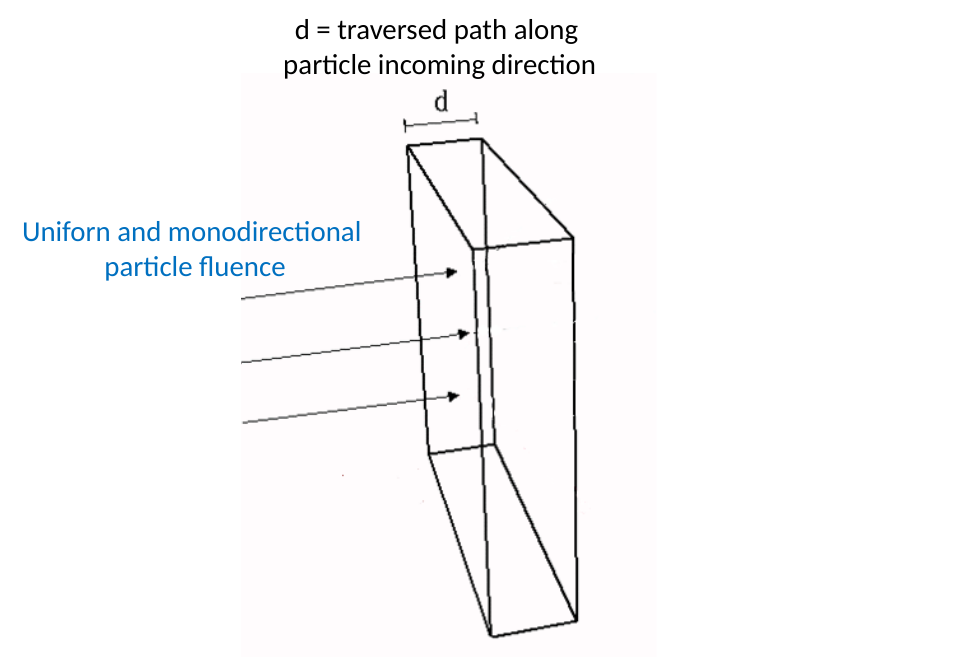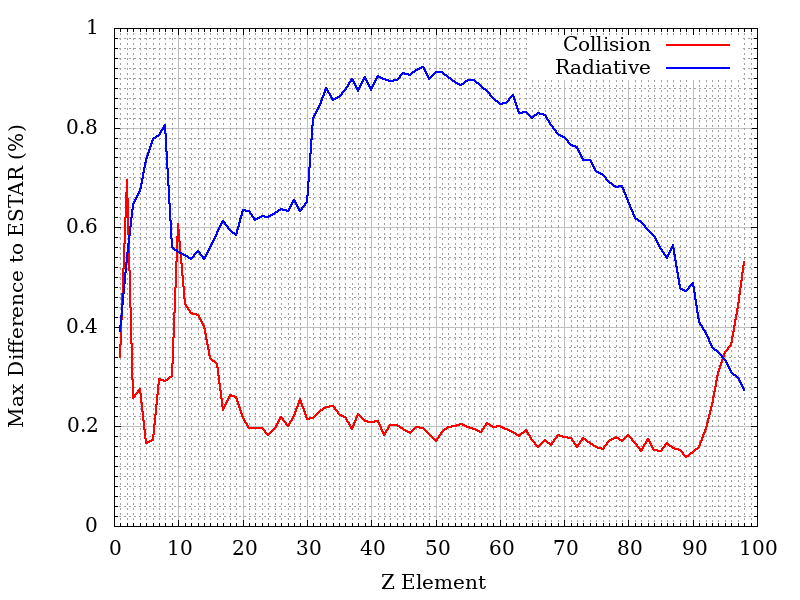The current web calculator allows one to obtain the residual spectral fluence or residual energy for electrons a shielding material by exploiting the collision electronic stopping power (based on a fit of the tables - based on ICRU Report 37 - from ESTAR code at NIST) and the radiative stopping powers (those evaluated in ESTAR - e.g., see webpage). The fitting function is a polynomial of degree 15 and the tables are reproduced with a maximum discrepancy < 1%.
In ESTAR webpage at NIST, the uncertanties regarding the collision and radiative stopping power are discussed as reported in the following. The uncertainties of the calculated collision stopping powers for electrons are estimated (ICRU, 1984) to be 1 % to 2 % above 100 keV, 2 % to 3 % (in low-Z materials) and 5 % to 10 % (in high-Z materials) between 100 keV and 10 keV. The increasing uncertainties at low energies are due to the lack of shell corrections which are required when the velocity of the incident electron is no longer large compared to the velocities of the atomic electrons, especially those in the inner shells. Because of this limitation, tabulations of collision stopping powers are customarily restricted to energies above 10 keV. A similar restriction is recommended in regard to the use of the ESTAR. Due to the omission of shell corrections, the stopping powers from ESTAR are expected to be too large at very low energies. It is estimated that for materials of low atomic number, such as water, air or plastics, the error will be to the order of 10 % at 1 keV. ESTAR will not run below 1 keV. Radiative stopping powers are evaluated in ESTAR with a combination of theoretical bremsstrahlung cross sections described by Seltzer and Berger (1985). Analytical formulas (using a high-energy approximation) are used above 50 MeV, and accurate numerical results of Pratt et al. (1977) below 2 MeV. Cross sections in the intermediate energy region from 2 MeV to 50 MeV are obtained by interpolation, a procedure whose accuracy was confirmed by more detailed calculations for a few cases. The uncertainties of the radiative stopping powers are estimated to be 2 % above 50 MeV, 2 % to 5 % between 50 MeV and 2 MeV, and 5 % below 2 MeV.
The following link give access to the Web Applications for the calculation of the residual spectral fluence or residual energy for electrons traversing an absorber:
How to use this Calculator for particle spectral fluences or mono-energetic particles traversing an absorber
For an incoming particle spectral fluence or mono-energetic particles, this tool allows one to calculate the residual spectral fluence or residual energy after traversing a shielding material.

The input parameters and options for the tool are described below. When the input form has been completed, pressing the "CALCULATE" button will start the calculation and open the "Results" page (allow for pop-up in your browser settings). The result page will be also linked at the bottom of the calculator page.
Input Parameters:
- Input type
- Target material (Single Element or Compound)
- Traversed path
- Number of steps
- Particle spectral fluence.
Input type
In the web Calculator, using the selector at the top of th calculator panel, the user can select the calculation of the residual spectral fluence or the residual energy for incoming protons or ions.
Spectral fluence is the default option: 
User has to change selection for mono-energetic particles:
Target Material
In the section "Target Selection" it is possible to specify Single Element target material or a predefined Compound material. Fraction by weight, mean excitation energy and densities of media are available here.
Following is the maximum difference percentage between the fit and ICRU tables for single elements as a functions of the target atomic number (Z):

The overall max difference for compounds is 0.36% for collision, 0.91% for radiative. The average difference is 0.17% for collision and 0.73% for radiative.
Traversed Path
This input define the traversed path by a particle fluence. The traversed path is expressed in [g cm-2] ad is given by:
(absorber thickness in cm) x (absorber density in g cm-3) .
The lower limit of traversed path is equivalent to about 5 μm of Si (1.16x10-3 [g cm-2]), e.g., 0.96 cm in Dry Air at sea level with density equal to 1.20484x10-3 g/cm3 (as implemented in SRIM from ICRU-37 table 5.5).
Number of Steps
In the web Calculator, using the pull down menu, the user can select the number of steps of the calculation - i.e., the traversed path is divided by the number of the steps.
The results of each steps is used as input for the following one to obtain the final result for the total traversed path.
In each step, the minimum traversed path is equivalent to about 5 μm of Si (1.16x10-3 [g cm-2]), e.g., 0.96 cm in Dry Air at sea level with density equal to 1.20484x10-3 g/cm3 (as implemented in SRIM from ICRU-37 table 5.5). The number of steps will be accordingly modified to keep each step above the minimum.
Particle Spectral Fluence
This section define the points of the spectral fluence as a function of energy.
The input format is one point per line (Energy - Flux , separated by a space or tab); it is also possible to copy and paste values. The minimum value of the particle spectral fluence is 1 keV.
Mono-Energetic Particle
This section define the list of energy of the incoming electrons.
The input format is one energy per line; it is also possible to copy and paste values. The minimum value of the particle energy is 1 keV.
Result
The result page contains the graph of the input spectral fluence and the spectral fluence after traversing the absorber. The table provides the values of the spectral fluence (above 1 keV) and the residual spectral fluence (above 1 keV) after traversing the absorber. In addition, the incoming and residual spectral fluences are provided. In case of mono-energetic particles a table with the incoming energy and residual energy is provided.
Residual energies were obtained disregarding multiple scattering effect, i.e., directions of flight of emerging particles were unchaged with respect to those of impinging directions.